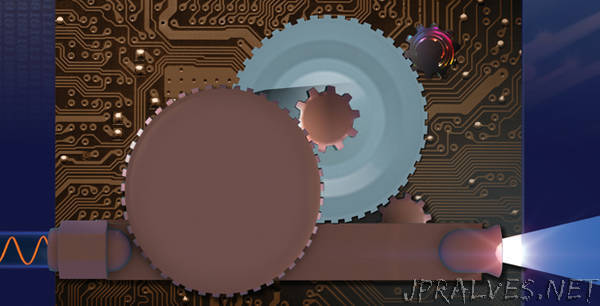
“Only a few decades ago, finding a particular channel on the radio or television meant dialing a knob by hand, making small tweaks and adjustments to hone in on the right signal. Of course, we now take such fine tuning for granted, simply pressing a button to achieve the same effect. This convenience is enabled by radio frequency synthesis, the generation of accurate signal frequencies from a single reference oscillator. The need for better radar in World War II drove the development of radio frequency control, and its miniaturization in subsequent decades revolutionized a host of military and consumer applications. Today, precise, stable frequency synthesizers are found everywhere, from GPS systems to smartphones and TV remote controls.
While radio frequency control has long since graduated, optical frequency control on the other hand still exists in the bygone “tuner knob” era. The absolute frequency (or color) of light from a laser is difficult to set with precision, and laser frequencies tend to drift. The development of the “optical frequency comb” garnered a Nobel Prize in 2005, and enabled the demonstration of the first optical frequency synthesizer. These systems, analogous to their radio-frequency counterparts, allow light to be generated on demand at exact wavelengths with errors of less than 10-15 or one-part-per-quadrillion.
Optical frequency synthesizers have proven extremely valuable in a variety of scientific endeavors, including searching the skies for far-off planets, detecting chemicals through sensitive laser spectroscopy, enabling high-precision light detection and ranging (LIDAR) by using light as a ruler to measure distance, and even supporting fundamental tests of theories by optically probing the physical constants of nature.
While they provide unprecedented performance, the use of optical frequency synthesizers has been limited to laboratory settings due to the cost, size, and power requirements of their components. To reduce these obstacles DARPA launched the Direct On-Chip Digital Optical Synthesizer (DODOS) program in 2014, and today researchers are revealing in a paper published in Nature that they have made significant progress advancing chip-based integrated photonics and nonlinear optics to miniaturize optical synthesizer components.
“The development of optical frequency synthesis has significantly enhanced our ability to accurately and precisely measure time and space,” said Gordon Keeler, the DARPA program manager leading DODOS. “However, our ability to leverage the technology has been limited. Through DODOS, we’re creating technologies that will enable broader deployment and unlock numerous applications. The goal is to shrink laboratory-grade capabilities down to the size of a sugar cube for use in applications like LIDAR, coherent communications, chemical sensing, and precision metrology.”
The paper published by the DODOS team in Nature details recent success achieved under the program by researchers from the National Institute of Standards and Technology (NIST) and partner institutions, including the University of California at Santa Barbara and the California Institute of Technology in Pasadena, California. Combining a pair of frequency combs, several miniature lasers, and other compact optoelectronic components, the researchers were able to replicate the capabilities of a tabletop-sized optical frequency synthesizer on four microchips–each only about 5 mm x 10 mm in size. The synthesizer can tune over 32 nm and delivers a frequency stability of 7 x 10-13 after one second of averaging, matching that of the input reference clock.
Leveraging advances in semiconductor fabrication, researchers created the two miniaturized frequency combs by circulating laser light generated with single-color “pump” lasers around optical racetracks fabricated on silicon chips. Doing so correctly can produce many additional colors, yielding a spectrum that looks like a hair comb where each “tooth” is an individual color, or frequency. This is a significant departure from the tabletop versions, which use fiber optics, specialized mirrors, and large mechanical components built by hand to achieve a similar effect.
The two frequency combs guide a programmable laser, which is an output of the synthesizer. One comb, created by NIST, has wider teeth and can calibrate itself by spanning an octave–which represents a doubling of frequency as in musical octaves. The team from Caltech created a second comb with much finer teeth that spans a narrower range. The distance between these teeth is set by a stable and accurate microwave reference clock. When lined-up to the NIST comb, the Caltech comb creates a grid of known optical frequencies for the output laser to reference–or measure itself against. In combination, the frequency combs create a synchronized link between the microwave clock and the laser frequency.
The DODOS program is entering its final phase, during which performers will work to integrate the individual components together with electronics and fabricate a compact packaged device suitable for use in future military and commercial optical systems.”
Link to article
